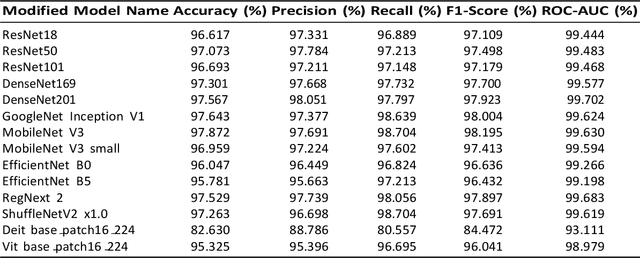Md Abu Sufian
University of Leicester, UK
Unleashing Modified Deep Learning Models in Efficient COVID19 Detection
Oct 21, 2023



Abstract:The COVID19 pandemic, a unique and devastating respiratory disease outbreak, has affected global populations as the disease spreads rapidly. Recent Deep Learning breakthroughs may improve COVID19 prediction and forecasting as a tool of precise and fast detection, however, current methods are still being examined to achieve higher accuracy and precision. This study analyzed the collection contained 8055 CT image samples, 5427 of which were COVID cases and 2628 non COVID. The 9544 Xray samples included 4044 COVID patients and 5500 non COVID cases. The most accurate models are MobileNet V3 (97.872 percent), DenseNet201 (97.567 percent), and GoogleNet Inception V1 (97.643 percent). High accuracy indicates that these models can make many accurate predictions, as well as others, are also high for MobileNetV3 and DenseNet201. An extensive evaluation using accuracy, precision, and recall allows a comprehensive comparison to improve predictive models by combining loss optimization with scalable batch normalization in this study. Our analysis shows that these tactics improve model performance and resilience for advancing COVID19 prediction and detection and shows how Deep Learning can improve disease handling. The methods we suggest would strengthen healthcare systems, policymakers, and researchers to make educated decisions to reduce COVID19 and other contagious diseases. CCS CONCEPTS Covid,Deep Learning, Image Processing KEYWORDS Covid, Deep Learning, DenseNet201, MobileNet, ResNet, DenseNet, GoogleNet, Image Processing, Disease Detection.
Enhancing Prediction and Analysis of UK Road Traffic Accident Severity Using AI: Integration of Machine Learning, Econometric Techniques, and Time Series Forecasting in Public Health Research
Sep 23, 2023Abstract:This research investigates road traffic accident severity in the UK, using a combination of machine learning, econometric, and statistical methods on historical data. We employed various techniques, including correlation analysis, regression models, GMM for error term issues, and time-series forecasting with VAR and ARIMA models. Our approach outperforms naive forecasting with an MASE of 0.800 and ME of -73.80. We also built a random forest classifier with 73% precision, 78% recall, and a 73% F1-score. Optimizing with H2O AutoML led to an XGBoost model with an RMSE of 0.176 and MAE of 0.087. Factor Analysis identified key variables, and we used SHAP for Explainable AI, highlighting influential factors like Driver_Home_Area_Type and Road_Type. Our study enhances understanding of accident severity and offers insights for evidence-based road safety policies.
 Add to Chrome
Add to Chrome Add to Firefox
Add to Firefox Add to Edge
Add to Edge